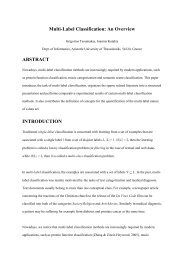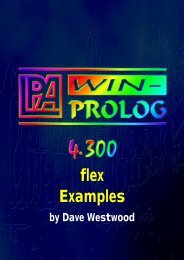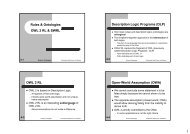Create successful ePaper yourself
Turn your PDF publications into a flip-book with our unique Google optimized e-Paper software.
7. Knowledge Specification Language 88<br />
Terminating The Engine<br />
<strong>flex</strong> toolkit<br />
Termination conditions may be set for a particular ruleset using the KSL<br />
keywords<br />
terminate when<br />
followed by some conditions. This provides an alternative way of stopping<br />
the <strong>flex</strong> program: without termination conditions the forward chaining<br />
engine stops when no more rules can be fired.<br />
Examples<br />
Selecting Rules<br />
ruleset example_set4<br />
contains all rules ;<br />
terminate when condition1 and condition2 .<br />
This specifies that the forward chaining engine will stop when both<br />
condition1 and condition2 are satisfied (even if there are still some<br />
rules which could be fired).<br />
ruleset pack_shopping<br />
contains pack_small_items, pack_large_items ;<br />
terminate when the shopping is empty .<br />
This specifies that the forward chaining engine will stop when the value of<br />
shopping becomes empty.<br />
Normally <strong>flex</strong> will consider each rule in the order specified in the ruleset.<br />
However, a number of alternative rule selection criteria may be applied<br />
instead, using the KSL keywords<br />
select rule using.<br />
The default rule selection is first come first served, which<br />
considers rules in the order in which they are given and fires the first rule<br />
whose conditions are satisfied.<br />
ruleset example_set5<br />
contains all rules ;<br />
select rule using first come first served .<br />
The rule selected for each cycle is the first rule in the agenda whose<br />
conditions are satisfied. This is the default for selecting rules and is<br />
equivalent to omitting any rule selection criteria.<br />
Rules may be selected using conflict resolution. In this case an<br />
attempt is always made to use the “best” rule according to the scoring<br />
system built into the rules. Each rule should have a score associated with it,<br />
and the conflict resolution system then fires the rule whose conditions are








